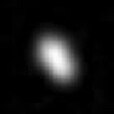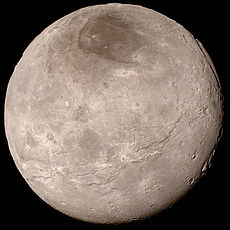Moons of Pluto
|
|||
(Images not to scale) |
(Images not to scale)
The dwarf planet Pluto has five moons down to a detection limit of about 1 km in diameter. In order of distance from Pluto, they are Charon, Styx, Nix, Kerberos, and Hydra. Charon, the largest of the five moons, is mutually tidally locked with Pluto, and is massive enough that Pluto–Charon is sometimes considered a double dwarf planet.
The innermost and largest moon, Charon, was discovered by James Christy on 22 June 1978, nearly half a century after Pluto was discovered. This led to a substantial revision in estimates of Pluto's size, which had previously assumed that the observed mass and reflected light of the system were all attributable to Pluto alone.
Two additional moons were imaged by astronomers of the Pluto Companion Search Team preparing for the New Horizons mission and working with the Hubble Space Telescope on 15 May 2005, which received the provisional designations S/2005 P 1 and S/2005 P 2. The International Astronomical Union officially named these moons Nix (or Pluto II, the inner of the two moons, formerly P 2) and Hydra (Pluto III, the outer moon, formerly P 1), on 21 June 2006.Styx, announced on 7 July 2012, was discovered while looking for potential hazards for New Horizons.
Charon is about half the diameter of Pluto and is so massive (nearly one eighth of the mass of Pluto) that the system's barycenter lies between them, approximately 960 km above Pluto's surface. Charon and Pluto are also tidally locked, so that they always present the same face toward each other. The IAU General Assembly in August 2006 considered a proposal that Pluto and Charon be reclassified as a double planet, but the proposal was abandoned.
...
Wikipedia





